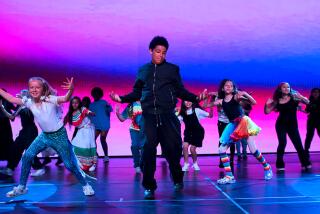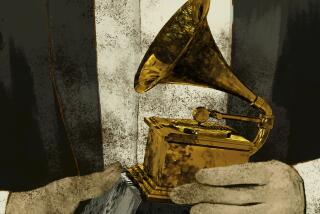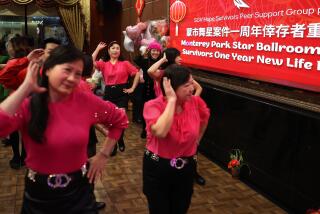Time to learn the next move
New York — Four women skitter across the floor, arms held with geometric intent. Another lone woman, exuding a quiet radiance, paces at an angle to them, oblivious.
“More like this,” explains Terese Capucilli, rising from her seat against a wall of the tiny, sweltering room. A former lead dancer with the Martha Graham Dance Company, now its co-artistic director -- and expecting a baby in March -- she demonstrates to the young chorus a gesture: a bit of the most famous movement style in the modern dance repertory. The dancers go through the motion, echoing it, assuming it and finally catching some of the quality that gives it the unmistakable accent of Graham technique.
It’s almost like watching a game of Telephone, in which a sentence, whispered from one player to another, starts to change. The idea of owning a dance is bound up with reversing this process, bringing the movement, intact, from another’s body into yours. The dance they’re working on is “Appalachian Spring,” from 1944. It belongs to everybody -- and nobody.
The Martha Graham Dance Company, rehearsing for its first season in three years, at New York’s Joyce Theater, is emerging from one of the dance world’s most-watched lawsuits. The company was shut down starting in 2000 while Ron Protas, Graham’s legal heir, and the board of the Martha Graham Center and School of Contemporary Dance battled over the rights to the Graham name and the dances she created.
In court, Protas’ argument was that Graham, in her will, left him everything she owned. The center’s argument was that Graham had created her dances while technically a center employee, and that they were therefore “work for hire” and belonged to the center.
The issue has proven hotly divisive. Protas, on the one hand, is widely loathed in the dance world, accused of manipulating Graham when she was weak and elderly, selling off parts her legacy after her death for his own profit, running the center into the ground.
The term “work for hire,” on the other hand, has been a red flag to others who bristle at the idea that a choreographer should be viewed as a mere employee of her own board.
There was, accordingly, much debate when, on Aug. 23, U.S. District Court Judge Miriam Cederbaum ruled in the center’s favor. Of the 70 Graham dances that can still be reconstructed, the company, she decided, has rights to 45; commissioning organizations own five; nine are ambiguous; and 10 -- including “Appalachian Spring” -- are in the public domain. Protas holds rights to one.
To the company, it’s a clear-cut victory for the rights of artists. Dancers speak of Graham’s work being “liberated.” “So many individuals and companies share our excitement that the work is back in hands of the people,” says Capucilli.
Others are not so sanguine. “It raises some serious legal issues,” says Charles Reinhart, president of the American Dance Festival in North Carolina, who sees the ruling as a blow against the rights of choreographers. “Suppose ADF says, ‘Wait a minute: We commissioned her to do that work; that should belong to ADF.’ We, ADF, have commissioned 500 works. We’ve never said who the work belongs to.”
And Protas -- who is appealing the decision -- seems to be in a tailspin, repeating a litany of his grievances. Graham “did not want her name and her aesthetic controlled artistically by anyone except me,” he says. “History is being rewritten. Martha has been misrepresented, by this board, and these people, who knew the truth.”
Advisor, caretaker, companion
Martha Graham and Ron Protas first intersected in 1967, when he was an aspiring twentysomething photographer and she was in her 70s, still head of her dance company and its umbrella organization, the center. But the pioneering grande dame of modern dance was also ill, and uncertain about her future.
The two were soon inseparable. “We were joined at the hip; she was my family,” says Protas, who became her advisor, caretaker and constant companion. Graham, he says, was “terribly worried” about attempts to displace her at the head of her empire, and Protas took it on himself to help shore up her authority -- and by extension, his own. He began working at the center in 1972; within a few years he was co-director; and, as Graham’s sole heir, he took over as artistic director at her death in 1991.
He was not, however, popular with many of the dancers or board members. “Ron mistreated people,” says Elizabeth Auclair, who joined the company that same year. “A lot of fear was generated; very rough energy. The environment was very difficult to work in.”
That effect wasn’t lost on the larger dance community. “In May ‘97,” says Francis Mason, chairman emeritus of the Graham board, “Protas called me up and said, ‘Will you please go to see the Harkness Foundation? They normally give us $20,000.’ ” Mason says he and the center chairman, Judy Schlosser, met with Ted Bartwink, head of the foundation, and were told that Protas was a stumbling block, that they weren’t going to be able to raise money with him in place.
“I said, ‘Look, he’s her heir,’ ” Mason continues. “And he said, ‘Does he own it?’ When Martha died, we all should have asked it.”
It turned out to be the $64,000 question. The wording of the will even left it open. “All ... tangible personal property ... if owned by me at the time of my death, I give and bequeath to my said friend Ron Protas,” it states. As early as 1992, Protas’ own lawyers suggested he needed to establish exactly what copyrights Graham had owned at her death.
That suggestion would come back to haunt him when he sued the center in 2001. He and the board were already in a state of open warfare. The board had tried to cajole him onto the sidelines for several years, says Marvin Preston, who became the center’s executive director in March 2000. Protas responded by setting up a trust to license the Graham dances to the center; the trustees signed on, thinking Protas would then step aside as artistic director.
Protas, however, wasn’t budging. Meanwhile, the company was in ever direr financial straits. In 1999, the Graham building on East 63rd Street was sold. Even that couldn’t fix the cash flow problem.
In 2000 things came to a head. The trustees voted to remove Protas as artistic director in March; in June, they voted him off the board altogether. At the same time, they suspended operations at the nearly bankrupt center. Protas’ reaction was swift. He notified the center that the licensing agreement was withdrawn. And in January 2001, when the school resumed operations, “he immediately filed a lawsuit for use of the name, use of the dances, everything,” says Preston.
In the course of the trial, the center’s lawyers offered evidence -- old income tax returns, personal letters -- that Graham had transferred rights in her dances to the center when she set it up in 1956. As late as the ‘70s, a number of documents echoed that the center, not Graham personally, held the rights.
Those documents persuaded Cederbaum. Protas was “not a credible witness,” she wrote in the ruling. A part of the ruling stipulates that he pay back to the center $87,000 he personally netted from selling some of the Graham archive to the Library of Congress. In the end, he was left with a single dance, “Seraphic Dialogue,” because the center had neglected to renew the copyright, so it had reverted back to its creator.
Two roads to the future
Despite the worries in the dance community, the nature of the Graham decision -- grounded in specific ownership documentation, dance by dance -- makes it unlikely that the center’s win will impinge on choreographers’ rights. Choreographers just need to make their claims clear -- “a one-line statement will do it,” Preston says -- to assure their rights, on paper at least.
And, ultimately, the dance world debate over the battle may be more about underlying issues than the particulars of Cederbaum’s findings.
The living heads of America’s major dance companies -- Merce Cunningham, Paul Taylor, Twyla Tharp -- are facing, more or less urgently, the same questions the Graham case raises: What remains of a choreographer’s art after he or she is gone? What does it mean to “own” a dance? How can any dance legacy be protected and preserved?
“I don’t think artists have faced this clearly,” says Senta Driver, a former choreographer and active board member of the Dance Notation Bureau, which preserves dances by writing them down. “It’s cumbersome to keep dance alive, to keep it coached. The issue isn’t solved by leaving the rights explicitly to your dog.”
People who care about Graham’s work inevitably care about how it will be carried on. Even before the suit, many observers questioned whether anyone could fully re-create the charged emotionalism that was a Graham hallmark -- without the intensity of Graham herself.
The Graham company intends to try. Preston plans to notate and archive all the dances available to him, restoring and updating old video footage. And, although specific plans for a tour after the Joyce season are not firm, he also wants the company to dance full time. “As broke as we are,” he says, “you either stay small or you fill City Center. You don’t have any in between.”
Protas means to try, as well. “I don’t care how silly people want to make me seem,” he says. “You take the period after Martha died and read the reviews. They were good. People didn’t like me -- I would say, ‘You’re leaving out part of the choreography,’ or ‘This is wrong’ -- but I was right.”
His plan is to establish a new trust with a new name -- “Ron Protas Martha Graham,” he suggests -- and devote himself to raising money “to set performances of her work to her standards,” with former Graham dancers who are willing to work with him. And, of course, there is his appeal. His lawyer, Judd Burstein, calls it a strong case: “The trial court,” he says, “completely misapplied the law.”
Headed back to the stage
IN May 2002, in the middle of the trial, the Graham company reconstituted for a single, illicit and highly charged performance in New York City. In September, after the ruling, the dancers took part in a three-week workshop on “Appalachian Spring” and “Chronicle.” Then they went into rehearsals for the Joyce season in January.
“The rehearsal period is longer than we ever had,” says Christine Dakin, another company dancer and the troupe’s other artistic director, “but we have so many new people.” More than half of the 27 dancers are new, although all came up through the school. And the Joyce season involves 15 ballets from eight decades, from “Heretic” (1929) to “Maple Leaf Rag” (1990). “The pressure now is not just about learning a step,” Dakin says, “we hope that it will sink into their bones.”
In 2003, the company will take over a new home, at its old address, moving into space within the building that was erected at the former Graham site. Occupying the same space, yet with a new appearance and structure: It’s an appropriate metaphor for a group whose future is still open.
“We did the easy part -- we won,” says Dakin. “Now all we have to do is the hard part -- keep the company alive.”
*
Martha Graham Dance Company
When: Jan. 21 to Feb. 2
Where: Joyce Theater, 175 8th Ave., New York
Contact: (212) 242-0800
More to Read
The biggest entertainment stories
Get our big stories about Hollywood, film, television, music, arts, culture and more right in your inbox as soon as they publish.
You may occasionally receive promotional content from the Los Angeles Times.










